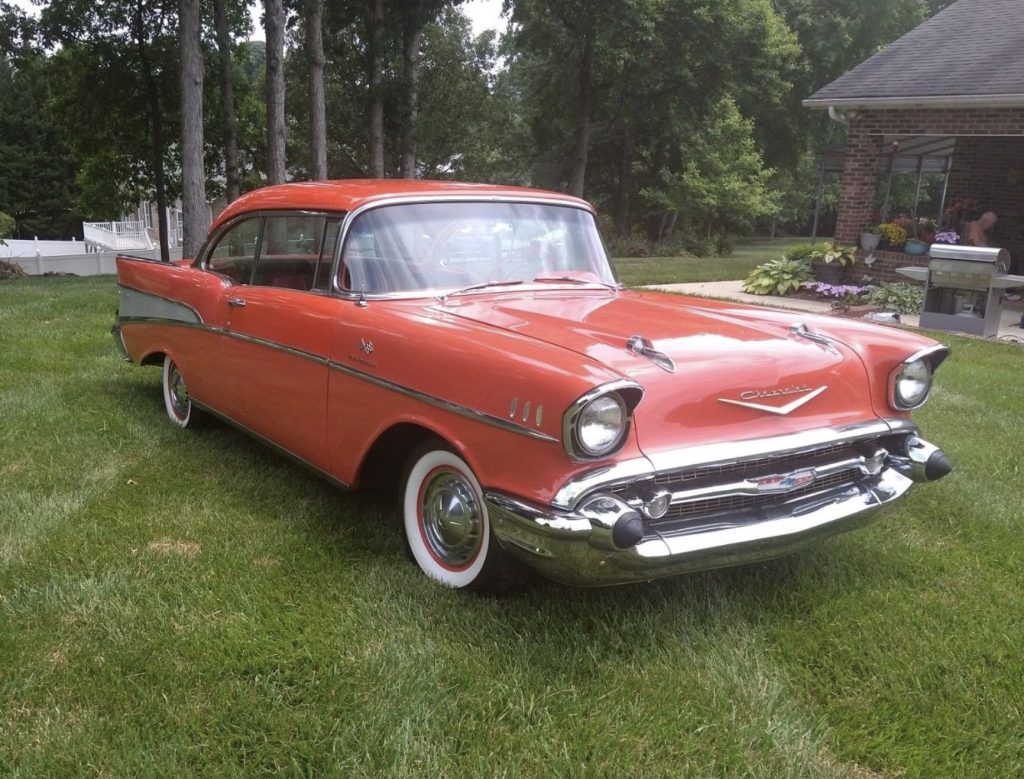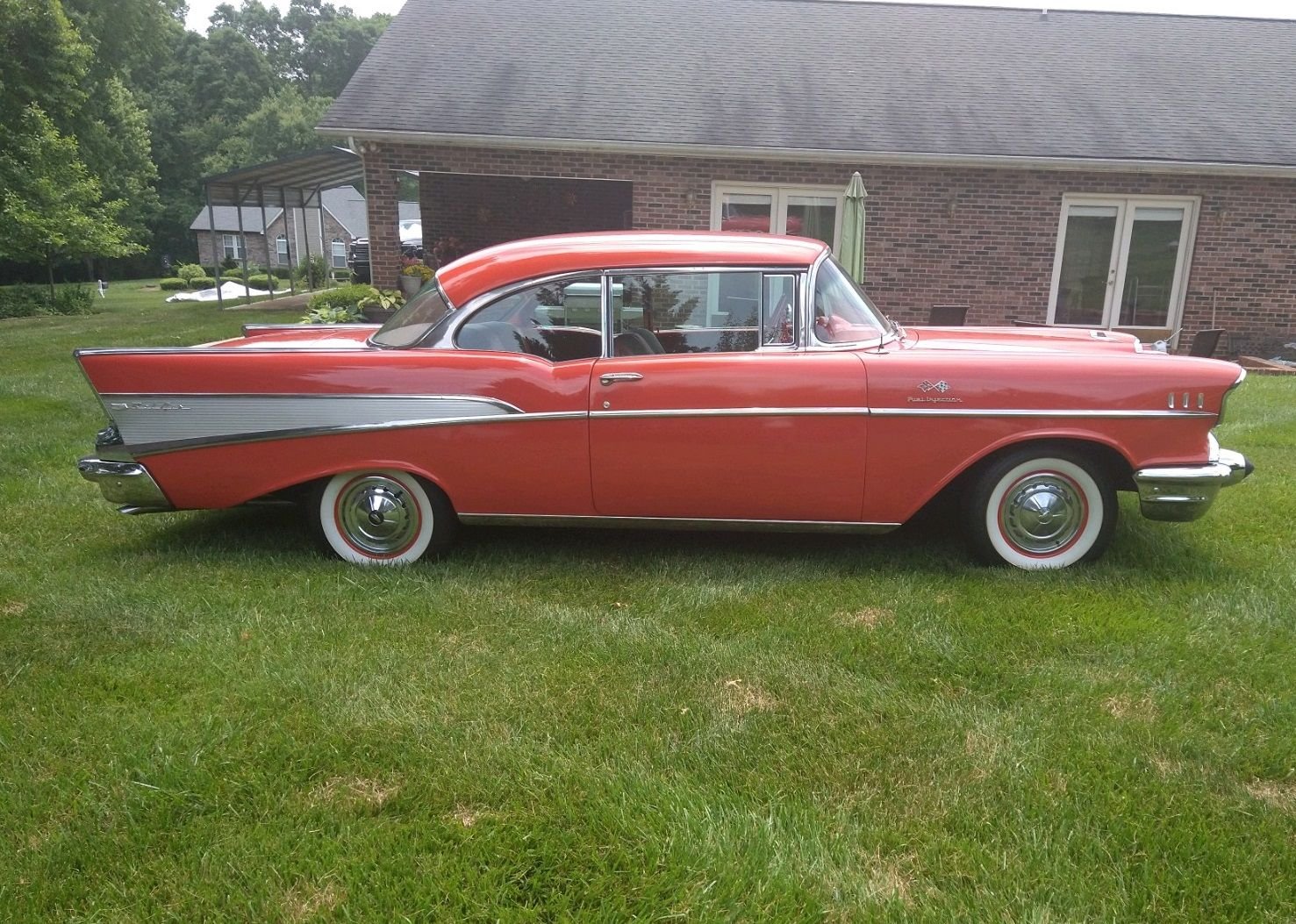The 1957 Chevrolet Bel Air is one of the most iconic classic American cars ever made. With its sweeping lines, tailfins, and chrome accents, the ’57 Bel Air defined the look of 1950s automotive styling and remains a highly sought-after collector’s item to this day. In this in-depth post, we’ll explore the history, design, performance, and lasting cultural impact of the 1957 Chevrolet Bel Air.

Overview of the 1957 Bel Air
The Bel Air trim level was introduced by Chevrolet in 1953 as a premium sub-series of its popular fleetline models. By 1957, the Bel Air had established itself as Chevy’s flagship car, offering luxurious styling touches, upgraded interior materials, and powerful V8 engine options.
Some key facts about the 1957 Bel Air:
- Offered as a 2-door coupe, 4-door sedan, or convertible body style
- Base price started around $2,200 (equivalent to about $22,000 today)
- Weighed approximately 3,200 pounds
- Length of 209.9 inches, width of 75.3 inches
- Powered by a range of V8 engines from 283 to 348 cubic inches
- Available with manual or automatic Powerglide transmission
Exterior Styling and Design
The 1957 Bel Air’s exterior styling represents the pinnacle of 1950s automotive design. It embodied the aviation and jet age themes that were popular in the era, with its large tailfins evoking images of rocket ships.
Sweeping Body Lines
The body featured long, sweeping curves along the front fenders, doors, and rear quarter panels. This gave the Bel Air a feeling of motion even when parked. The lines flowed elegantly from front to rear to create a graceful, unified whole.
Signature Tailfins
The most striking feature was the set of large, chrome-edged tailfins extending rearward from the backlight area. This stylistic motif was inspired by the twin rudders of the newly introduced Lockheed P-38 Lightning fighter plane. The fins gave the Bel Air a space-age flashiness combined with a nostalgic nod to earlier automotive styling.
Abundant Chrome Detailing
Brightwork trim and chrome accents were applied generously across the exterior. Body side moldings, window frames, gravel shields, window visors, and bumper grille bars all came plated in shiny chrome, contrasting elegantly against the car’s colorful paintwork. This extensive use of chrome reflected the optimism and flamboyance of 1950s American culture.
Interior Features and Comfort
The 1957 Bel Air’s interior focused on spaciousness, comfort, and premium materials to deliver an inviting cabin for both driver and passengers:
Roomy Dimensions
With its generous exterior proportions, the Bel Air also afforded excellent interior room, with space for six passengers in the sedan body style. Wide bench seats with soft foam cushions were standard front and rear.
Upgraded Upholstery Options
Seat upholstery choices included cloth-and-vinyl or all-vinyl trim. Higher trim levels offered patterned cloth with leather bolsters for a touch of luxury. Thick carpeting lined the floor pans for a quieter, plusher ride.
Curved Dash Design
The dashboard featured a gracefully curved design wrapping around the cabin. An aluminum appliqué panel housed round gauges in a stylish jet-age motif. Controls were designed for simplicity and ease of use.
Available Power Conveniences
Options included a power seat, power windows, power steering, and an AM radio. Air conditioning provided comfort in hot weather, while a heater/defroster helped with cold climes.
Engine and Performance
A range of powerful V8 engines provided tire-smoking performance capability:
Base 283 V8
The standard engine was an overhead-valve 283 cubic inch V8. It produced 185 horsepower with the standard 2-barrel carburetor, or 220 horsepower when upgraded to Rochester 4-barrel carb.
Optional Powerplants
Larger displacement options included a 327 cubic inch V8 with up to 250 horsepower, and the top-line 348 cubic inch motor pumping out a prodigious 280 horsepower.
Responsive Handling
The rigid X-frame chassis provided a stable foundation. Short and Long Arm front suspension along with leaf springs in back allowed for responsive cornering while smoothing out road imperfections. Steering was a recirculating-ball design providing a nimble, low-effort feel.
Powerglide Transmission
Shifting duties were handled by the 2-speed Powerglide automatic transmission. For manual control, the floor-mounted gear lever allowed drivers to select Low or Drive. Optional overdrive added highway cruising comfort.
Cultural Influence and Collectability
More than any other car of its time, the 1957 Bel Air stands as the quintessential symbol of 1950s Americana:
Hollywood Recognition
The elegant Bel Air convertible has appeared in countless films/TV shows as the perfect embodiment of ’50s cool. From American Graffiti to The Hours, it represents the bold, flashy exuberance of the era.
Rock ‘n Roll Imagery
With its streamlined fins and gleaming chrome, the ’57 Chevy epitomized the flash and thrill of early rock ‘n roll. Artists like Chuck Berry and Elvis Presley appeared with their Bel Air coupes which amplified their rebellious images.
Enduring Popularity
For decades, the 1957 Bel Air has inspired intense devotion among collectors, customizers and hot rod builders. Its timeless design ensures excellent resale values, with pristine examples selling for over $100,000.
Vintage Drag Racing
The lightweight, high-horsepower Bel Air coupes of the late ’50s were naturally suited to drag racing. Many vintage “Gasser” racers on the classic car show circuit started out as ’57 Chevys.
The Bel Air was the right car at the right time, cementing Chevrolet as an iconic American brand during the postwar boom years. More than 60 years later, its impact on our culture remains indisputable.
Collector’s Guide to Buying a 1957 Bel Air
For the avid collector seeking to purchase one of these classics, here are some tips on what to look for in assessing condition:
Check Fit and Finish
Examine panel gaps, door/hood alignment and windshield trim seals. Misalignments can indicate a past collision or poor quality restoration.
Inspect Chrome and Trim
Look for pitting, flaking or rust on the chrome bumpers, grilles and trim pieces. Rechroming costs add up quickly.
Verify Numbers Matching
Ensure the VIN code, body code plate and engine stamping numbers match what’s on the title and factory documentation. Numbers-matching cars bring higher valuations.
Assess Floorpans and Quarters
Check beneath door sills and in trunk for any signs of rust-through or crude patch repairs on the sheet metal. Floors and lower fenders are most prone to rust.
Operate All Systems
Test all lights, gauges, radio, windows and switches to spot any flaws. Turn wheels fully left and right when on the ground to check steering gearbox play.
Road Test Performance
Take it for a lengthy drive checking for proper operation of brakes, shocks and drivetrain. Listen for odd noises that could indicate issues.
Restoration Tips to Achieve Showroom Condition
Full professional concours restoration of a 1957 Bel Air easily exceeds $100K. Here are some budget-friendly tips for bringing that barn find back to its former glory:
Clean and Detail All Parts
Disassemble components fully, soak metal and chrome parts to remove grime and polish. Clean behind dash, inside trunk and door panels.
Refresh Interior Soft Goods
Install new headliner, carpet and seat covers/foam. Recover or replace cracked/dry door and kick panels.
Address Any Rust Issues
Cut out rusted floor sections, trunk and fender spots and weld in fresh steel. Apply rust converter primer before final paint.
Straighten Minor Dents
Use slide hammers or stud weld pullers to finesse out dings and small depressions in panels and trim pieces before painting.
Spray Professional Clearcoat
After wet-sanding and buffing the OEM lacquer paint, apply a clearcoat layer to create the deep, glossy wet-look seen on concours show cars.
Common Problems and Solutions
Even well-maintained Bel Airs can develop some recurring issues. Here are a few to watch out for along with potential fixes:
Q: What causes the curvature and cracks seen in the stainless body side trim?
A: Over time, the thickness of the underlying body lead filler shrinks, allowing the trim to bend and crease. Carefully remove and re-lead the body before reinstalling trim.
Q: Why does my ’57 Bel Air stall at stop signs despite a recent carb rebuild?
A: The cork-style float in the carburetor may have taken on fuel causing it to sink and flood the engine. Replace the float to prevent gas from entering engine when stopped.
Q: How do I reduce ride harshness from the rear leaf springs?
A: Old springs may be sagging, causing a stiff ride. Re-arch springs or install replacement leaves to restore normal spring rates and ride comfort.
Q: What’s the best way to quiet down the distracting exhaust rumble at highway speeds?
A: Your mufflers may have rusted out internally. Replace them with premium reproductions from Dynomax or MagnaFlow to enjoy quieter cruising.
Q: Why does my Bel Air lack heat despite good coolant flow?
A: Clogged heater core tubes prevent hot coolant from reaching the heater core. Use a backflush kit to clear out the tubes and restore proper heater function.
Closing Thoughts
In the world of collector cars, the 1957 Chevrolet Bel Air ranks among the all-time greats. Its iconic styling represents the best of GM design during the golden era of 1950s motoring. Fast, comfortable, and elegant, the ’57 Bel Air coupes and convertibles remain coveted by enthusiasts worldwide. From its gleaming chrome bullet taillights to its jet-inspired cockpit, this vehicle defines the American automotive dream. If you have the opportunity to own one of these beauties, take care of it well – you’ll be preserving an important part of our nation’s cultural heritage.






